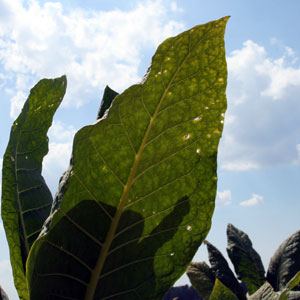Yunnan scientists believe tobacco roots are the key to higher leaf quality.
By Congming Zou
 Zimbabwe and the U.S. state of North Carolina are well-known for their high-quality flue-cured tobaccos. In addition to their suitable climate conditions, their sandy soils provide an excellent rhizosphere for tobacco root extension. By contrast, the texture of most soils in China’s Yunnan province—which produces about 20 percent of the world’s flue-cured tobacco—is silty loam or even clay, which impedes tobacco root penetration.
Zimbabwe and the U.S. state of North Carolina are well-known for their high-quality flue-cured tobaccos. In addition to their suitable climate conditions, their sandy soils provide an excellent rhizosphere for tobacco root extension. By contrast, the texture of most soils in China’s Yunnan province—which produces about 20 percent of the world’s flue-cured tobacco—is silty loam or even clay, which impedes tobacco root penetration.
This presents a challenge especially in the late period of tobacco growth, when some roots become old and lose function. The insufficiently developed root will limit nutrient acquisition (especially of potassium) and further affect tobacco quality. To address this problem, the Yunnan Academy of Tobacco Agricultural Science (YATAS), an important tobacco research center in southern China, has recently started to investigate tobacco roots in field conditions.
The tobacco root plays an important role in plant growth and leaf chemistry. On the one hand, it physically supports the plant and absorbs water and nutrients from soil. On the other hand, the tobacco root is where the synthesis takes place of many important compounds, such as alkaloids. Traditionally, agronomists have focused only on the aboveground parts of plant. More recent works suggest that successful crop varieties are due to bigger root systems, which allow the plant to absorb from the soil the required water and nutrients more efficiently.
Despite its significance for plant growth, the tobacco root has been rarely studied. Some scientists have dug up roots, but that approach is labor-intensive and fails to provide a true picture of root distribution in field conditions. So YATAS has created a rain-protection shed with a belowground lobby, where roots can be viewed under the real production conditions (Figure 1).
The setup contains three types of soils with different textures, including sandy soil, silty loam soil and clay soil. Through the observation windows in the lobby, researchers observed the longest tobacco roots in the sandy soil and the shortest in clay soil. The roots in the silty loam soil were somewhere in between (Figure 2).
These results confirmed that sandy soil can produce better-quality flue-cured tobacco. Also, the test site features polymethyl methacrylate tubes with coarse texture media, where tobacco root can be tested for its penetration potential and scanned from the different angles. Figure 3 shows that flue-cured tobacco grown in PMMA tubes can develop roots with depths of up to 175 cm, which is rare under natural conditions.
Many agronomists believe that roots are the key to a second green revolution. This, they hope, will help solve the unintended economic and environmental consequences resulting from the inefficient nutrient applications associated with the first green revolution.
YATAS plans to further improve its visualization facility to fuel the development of new and improved tobacco varieties. By identifying the optimal tobacco root architectures and examining agronomic management systems to improve nutrient and water absorbing capabilities, the agency hopes to develop more drought-resistant varieties and increase the efficiency of fertilizer applications.
Congming Zou is a scientist at the Yunnan Academy of Tobacco Agricultural Science in Kunming, Yunnan Province, China.












